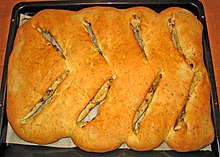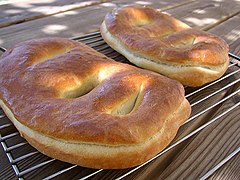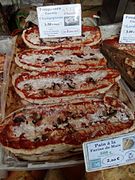Fougasse
The fougasse (also written fougace ) is a Provencal bread with a soft crust. It consists of soft yeast dough and is made from wheat flour , baker's yeast and olive oil . There are different versions, lightly sweetened, or with onions , olives, anchovies or bacon (lardons) . In the Alpes du Sud and Aigues-Mortes (Gard) area, sugared fougasse is also traditionally made. It is therefore the French equivalent of the Italian focaccia .
variants
The fougasse is usually made in flat baking molds and cut into so that several "branches" form.
Originally it was a "baking test" by the bakers, who used it to control the correct temperature in their ovens before they baked the actual bread. This also made it the morning meal for bakery employees (casse-croûte matinal) .

There are many variations. In addition to the ones already mentioned, the variant of Grasse , which is prepared with orange blossom , should also be mentioned.
Fougasse (al fogass) is also common in Algeria , in the Constantinois area, especially in the cities of Annaba and Guelma , where it is sold by hawkers. There they are served with shakshuka and seasoned with Ras el-Hanout .
etymology
The term "Fougasse" comes from the old Occitan fogatza and this in turn from the Latin * focācia. It is based on focācium ( n. Sg. ) "Something baked in the hearth ashes", a derivative of focus "hearth; Fire". This bread stands in the historical contrast to panis furnācius, the "bread baked in the oven".
The medieval fogatza developed into today's fogaça (according to the Norme classique de l'Occitan) or fougasso (according to the Norme mistralienne ) in Languedoc and Provençal ; in addition, the variants hogaça, hougasse in Gaskon - Béarnais and foaça, fouasso in northern Occitan.
A sweet cake made in the Aveyronnais Rouergue and in the Aveyron department is called fouace or fouasse in the local Occitan (Rouergat) .
Focācium is also the origin of the East French fouasse, fouace, fouée, the Catalan fogassa, the Spanish hogaza and the Italian focaccia . In Old High German the word became fochenza, and as an Alemannic and Bavarian dialect word it lives on in some cases to the present day. Via Middle High German, focācium has found its way into Polish (bochen, bochenek), Czech (bochník), Belarusian and Ukrainian (bóchon) as well as Russian (bóchanec, buchanec) , where it refers to the “loaf of bread”. Via the Greek fogatza, pogatsa (borrowed from Italian) it was adopted in the South Slavic languages , where it is pogača , but also again in Czech and Russian (pogátsch) and also into Hungarian (pogácsa), Austrian ( Pogatschen ) and Turkish (poğaça) .
gallery
Fougasses according Pizza -Art.
Individual evidence
- ^ A b Walther von Wartburg : French Etymological Dictionary . Volume 3. Teubner, Leipzig / Berlin 1934, p. 647 ff. (Article focācium ).
- ↑ Liliane Plouvier: Provence historique. fasc. 218, 2004: 434.
- ↑ C'est ma vie. Il était une fois la bonne fougasse de ammi Z'biri.
- ^ Dominique Auzias, Jean-Paul Labourdette: Alger 2012–2013. Petit Futé 2012 (Google Books).
- ↑ Site du CNRTL étymologie de fougasse² .
- ↑ Site du CNRTL étymologie de fouace .
- ↑ See Schweizerisches Idiotikon . Volume 1. Huber, Frauenfeld 1881/1885, Col. 625 ff. (Article Fochenze ).
- ↑ See Etymological Dictionary of Old High German . Volume 3. Vandenhoeck & Ruprecht, Göttingen 2007, Sp. 443-445 (article fochenza ).




